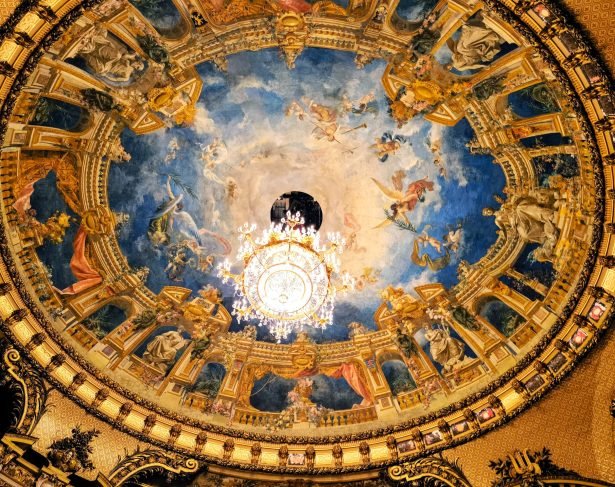La Monnaie – Five Fascinating Facts
La Monnaie can call itself the best opera house of 2024! The OPER! AWARDS jury conferred this coveted accolade on the Belgian opera house, at their meeting in Berlin. The prestigious award will officially be presented on 21 February 2025, at an awards show at La Monnaie. That this honour was won on merit is uncontested. However, this Grande Dame of Belgium has a past. Her past is as compelling and captivating as her present and her future. I was privileged to follow a guided tour of this vibrant institution. Five fascinating facts kept me riveted to every word shared by my very able guide.
1 – La Monnaie is the birthplace of the Belgian nation
The performance of La Muette de Portici (The Mute Girl of Portici), the groundbreaking opera, by Daniel Aubert was a particularly moving presentation. At La Monnaie, not a seat was empty. Every heart was full. The southern provinces of the then United Kingdom of the Netherlands, were a ticking political timebomb. These provinces were predominantly Catholic. This put them at loggerheads with “the north” which was overwhelmingly Protestant. The king, William of Orange, was seen as a despot.
The libretto by Germain Delavigne, and the lyricism of this magnificent piece of musical drama were the flash point for generations of pent-up emotions in the hearts of the audience. On 25 August 1830, in response to the nationalistic overtones of this opera, the theatregoers broke out in spontaneous renditions of patriotic songs. They spilled out of the theatre and took their reactionary melodies to the streets.

The Façade © Pieter Claes

The Dome – Mark Montgomery
The protest gathered momentum. It also attracted opposition. Predictably, violence ensued. The king, wrongly, assumed that the unrest was temporary. The political and social ramifications went on for some time. Ultimately, a provisional government was cobbled together, under the leadership of Charles Rogier. He entered into negotiations with the Dutch. As a result of his efforts, Belgium was officially declared an independent and sovereign nation on 4 October 1830.
2 – A nation on the ceiling
The original dome paintings, in the main hall, were the work of François-Joseph Nolau and Auguste Alfred Rubé. The ceiling art displays 2 themes. The first depicts the protection of the four arts. Four paintings give pride of place to the ancient and anchor crafts of Literature, Music, Painting and Sculpture. The second theme is political and patriotic. There are nine paintings that show the coats of arms of the 9 Belgian provinces.
The paintings were repainted in 1887 by Rubé and Philippe-Marie Chaperon. Further restoration was required and conducted from 1988 to 1989. The rendition that we enjoy today was unveiled in 1999.
3 – Gas lighting for a fashion revolution
Growing up, I came to view the opera as an elitist art form. I allowed myself to believe that it was an expression of creativity that was inaccessible to me – both because of status and cost. This misconception suffered its first corrective salvo in Warsaw, Poland.
Way back in 1985, a friend invited me to see the operatic version of My Fair Lady at Teatr Wielki – The Polish National Opera House. Poland was still in the steel grip of General Jaruzelski. What surprised me was the starting time of the event.
“Meet me at 15:45. We will have a quick drink before the show.” Before I could express my surprise at this early pre-show apero, she said “It starts at 16:30. We don’t want to be late.”
“Why so early?”
“Early? It’s not early. It’s convenient. This allows factory workers to come here directly from work. It avoids them having to go back to their homes in the suburbs and then come all the way back into the city.” She stated what was blatantly obvious to her.
My misconception of opera was shattered. Factory workers, in grimy overalls, found enjoyment in the opera, in a natural and uncontrived manner. It was a democratically accessible form of the performing arts. Research, developed in a separate article, will show that this is exactly how opera was born.
Originally, opera houses were candlelit. This dim illumination made it impossible to observe or cast judgment on how fellow theatre goers were dressed. When gas light was introduced, it blazed a spotlight on each and every one. Patrons then dressed to impress. This gave opera the unwelcomed aura of elitism.
La Monnaie, and other opera houses have now come full circle. I have never been accused of being a paragon of sartorial elegance. My “uniform” for almost any occasion is my faded jeans and a T-shirt or a hoodie. At La Monnaie I am not out of place. My co theatre goers are dressed from extreme casual to extreme elegant. Despite the state-of-the-art illumination, we all feel welcome. La Monnaie brings opera home to the people. And that is where it belongs.
3 – La Monnaie and the monastery
The site on which La Monnaie is built was the site of a monastery, as far back as the year 1465. The monastery was born out of the chagrin of the Duchess Isabella of Portugal. It troubled her that there was no presence of Dominican monks in the Brussels Republic. She sought and received approval from Pope Calixtus III. The Dominican monastery project was launched. The history of this monastery is the stuff of political and social intrigue with a good measure of scandal thrown in. Parts of the monastery have been converted into a spectacular hotel, which stands cheek by jowl with the opera house.

The Foyer © Simon Van Rompay

The galleries © Simon Van Rompay
In 2018 excavation began to link the theatre workshops to the theatre by means of a connecting tunnel. The remains of the monastery and of long interred monks were discovered. This revelation halted work for a considerable time. However, this established an undeniable link between the opera house and the monastery. Is this a coincidence? I don’t believe so. It is important to note that La Scala is built on the site of an historic church. Similarly, the Opera Royal de Wallonie, in Liege, is also built on the site of a former monastery. Three spectacular opera houses, each built on a sacred site of worship. I find it hard to believe that this is merely circumstantial. However, I am still at a loss to know if there are inferences to be drawn from this connection. Still, it is undoubtedly a Fascinating Fact.
4 – What’s in a name?
It was Napoleon Bonaparte who proposed the construction of a new opera house in Brussels. The current opera house is the third to be built in Brussels.
On the night of 13 to 14 August 1695, the troops of Louis XIV, King of France, bombarded Brussels. Most of the residents of Brussels managed to flee the city in flames. Many of the buildings around the Grand-Place were completely destroyed. Only a few façades, such as those of the Town Hall and the Maison du Roi, remained standing. Reconstruction began shortly after this event. In record time, the Grand-Place regained its beauty and alure.
The first permanent public theatre for opera performances of the court and city of Brussels was built between 1695 and 1700. This was executed as part of a rebuilding plan following the sacking of Brussels. The work was managed by the Venetian architects Paolo and Pietro Bezzi. The theatre was built on the site of a building that had served to mint coins. The name of this site, La Monnaie – “The Coins” was to remain associated with the theatre for centuries to come.
5 – In the pits
Traditionally, orchestras tune to the standard pitch of A=440 Hertz (440 vibrations per second). This is because every string instrument has an ‘A’ string. The orchestra at La Monnaie tunes to an A at 442+ hertz. This calibration is preferred because it gives a brighter sound. Tuning is led by the oboe. It is then followed, first by the wind instruments and then the strings. Once everyone is tuned and in sync, the conductor enters the orchestra pit. The pit is the recessed space between the stage and the audience. When the conductor enters the pit, it is show time!
The sound that floats from the orchestra pit is a cocktail of a variety ingredients. These will include the maestro’s interpretation of the work, the positioning of the instruments in relation to one another and the size of the orchestra. It is a little-known fact that the depth of the pit plays a vital role in producing the desired sound. At La Monnaie, the floor of the pit can be raised or lowered, as required. The depth of the pit can be modified to enhance the production of sound profiles. Some works, such as the operas of Wagner or Strauss, call for a larger orchestra. Other works, such as some composed by Rossini or Verdi, may require smaller orchestras. Equally, some works have deep, resonant, tones. Others may have higher range, lighter tones. The floor of the pit will be raised or lowered to optimised acoustics on a case-by-case basis.
La Monnaie organises excellent tours of the theatre, on a regular basis. The superb guides provide entertaining commentary, to small groups, in English, French and Dutch. You can book your Discover La Monnaie tour HERE

The stage and pit area © Simon Van Rompay

